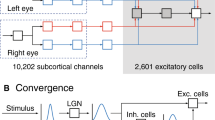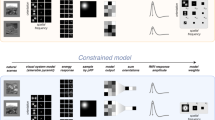Abstract
IN the mammalian visual cortex, many neurons are driven binocularly and response properties such as orientation preference or spatial frequency tuning are virtually identical for the two eyes1. A precise match of orientation is essential in order to detect disparity and is therefore a prerequisite for stereoscopic vision. It is not clear whether this match is accomplished by activity-dependent mechanisms together with the common visual experience normally received by the eyes2,3, or whether the visual system relies on other, perhaps even innate, cues to achieve this task4–7. Here we test whether visual experience is responsible for the match in a reverse-suturing experiment in which kittens were raised so that both eyes were never able to see at the same time. A comparison of the layout of the two maps formed under these conditions showed them to be virtually identical. Considering that the two eyes never had common visual experience, this indicates that correlated visual input is not required for the alignment of orientation preference maps.
This is a preview of subscription content, access via your institution
Access options
Subscribe to this journal
Receive 51 print issues and online access
$199.00 per year
only $3.90 per issue
Buy this article
- Purchase on Springer Link
- Instant access to full article PDF
Prices may be subject to local taxes which are calculated during checkout
Similar content being viewed by others
References
Hubel, D. H. & Wiesel, T. N. J. Physiol. 160, 106–154 (1962).
Blakemore, C. & Van Sluyters, R. C. J. Physiol. 248, 663–716 (1975).
Barlow, H. B. & Pettigrew, J. D. J. Physiol. 218, 98–100 (1971).
Hubel, D. H. & Wiesel, T. N. J. Neurophysiol. 26, 994–1002 (1963).
Wiesel, T. N. & Hubel, D. H. J. comp. Neurol. 158, 307–318 (1974).
Albus, K. & Wolf, W. J. Neurophysiol. 348, 153–185 (1984).
Braastad, B. O. & Heggelund, P. J. J. Neurophysiol. 53, 1158–1178 (1985).
Wiesel, T. N. & Hubel, D. H. J. Neurophysiol. 26, 1003–1017 (1963).
Imbert, M. & Buisseret, P. Expl Brain Res. 22, 25–36 (1975).
Kim, D.-S. & Bonhoeffer, T. Nature 370, 370–372 (1994).
Blasdel, G. G. & Salama, G. Nature 321, 579–585 (1986).
Ts'o, D. Y., Frostig, R. D., Lieke, E. E. & Grinvald, A. Science 249, 417–420 (1990).
Bonhoeffer, T. & Grinvald, A. Nature 353, 429–431 (1991).
Bonhoeffer, T. & Grinvald, A. J. Neurosci. 13, 4157–4180 (1993).
Movshon, J. A. J. Physiol. 261, 125–174 (1976).
Sillito, A. M., Kemp, J. A., Berardi, J. & Berardi, N. Brain Res. 194, 517–520 (1980).
Crook, J. M. & Eysel, U. T. J. Neurosci. 12, 1816–1825 (1992).
Schwarz, C. & Bolz, J. J. Neurosci. 11, 2995–3007 (1991).
Fitzpatrick, D., Zhang, Y., Schofield, B. R. & Muly, E. C. Soc. Neurosci. Abstr. 19, 179.2 (1993).
Bonhoeffer, T. & Kim, D.-S. in Challenges and Perspectives in Neuroscience (ed. Ottoson, D.) 117–138 (Elsevier, Oxford 1995).
Meister, M., Wong, R. O. L., Baylor, D. A. & Shatz, C. J. Science 252, 939–943 (1991).
Tanaka, K. J. Neurophysiol. 49, 1303–1318 (1983).
Chapman, B., Zahs, K. R. & Stryker, M. P. J. Neurosci. 11, 1347–1358 (1991).
Ferster, D. J. Neurosci. 6, 1284–1301 (1986).
Reid, R. C. & Alonso, J. M. Nature 378, 281–284 (1995).
Author information
Authors and Affiliations
Rights and permissions
About this article
Cite this article
Gödecke, I., Bonhoeffer, T. Development of identical orientation maps for two eyes without common visual experience. Nature 379, 251–254 (1996). https://doi.org/10.1038/379251a0
Received:
Accepted:
Issue Date:
DOI: https://doi.org/10.1038/379251a0
This article is cited by
-
Functional neuronal circuits emerge in the absence of developmental activity
Nature Communications (2024)
-
A model for the development of binocular congruence in primary visual cortex
Scientific Reports (2022)
-
Summation of connectivity strengths in the visual cortex reveals stability of neuronal microcircuits after plasticity
BMC Neuroscience (2015)
-
Statistics and geometry of orientation selectivity in primary visual cortex
Biological Cybernetics (2014)
-
Emergence of binocular functional properties in a monocular neural circuit
Nature Neuroscience (2008)
Comments
By submitting a comment you agree to abide by our Terms and Community Guidelines. If you find something abusive or that does not comply with our terms or guidelines please flag it as inappropriate.



